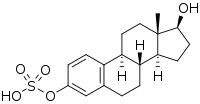Estradiol sulfate
 | |
| Names | |
|---|---|
| IUPAC name
[(8R,9S,13S,14S,17S)-17-Hydroxy-13-methyl-6,7,8,9,11,12,14,15,16,17-decahydrocyclopenta[a]phenanthren-3-yl] hydrogen sulfate | |
| Other names
Estra-1,3,5(10)-triene-3,17β-diol 3-sulfate | |
| Identifiers | |
| 3D model (JSmol) |
|
| ChEBI | |
| ChemSpider | |
| PubChem CID |
|
| UNII | |
| |
| |
| Properties | |
| C18H24O5S | |
| Molar mass | 352.44516 g/mol |
| Except where otherwise noted, data are given for materials in their standard state (at 25 °C [77 °F], 100 kPa). | |
| Infobox references | |
Estradiol sulfate (E2S), or 17β-estradiol 3-sulfate,[1] is a natural, endogenous steroid and an estrogen ester.[2] E2S itself is biologically inactive,[3] but it can be converted by steroid sulfatase (also called estrogen sulfatase) into estradiol, which is a potent estrogen.[2][4][5] Simultaneously, estrogen sulfotransferases convert estradiol to E2S, resulting in an equilibrium between the two steroids in various tissues.[2][5] Estrone and E2S are the two immediate metabolic sources of estradiol.[6] E2S can also be metabolized into estrone sulfate (E1S), which in turn can be converted into estrone and estradiol.[7] Circulating concentrations of E2S are much lower than those of E1S.[1] High concentrations of E2S are present in breast tissue, and E2S has been implicated in the biology of breast cancer via serving as an active reservoir of estradiol.[2][4]
As the sodium salt, sodium estradiol sulfate, E2S is present as a minor constituent (0.9%) of conjugated equine estrogens (CEEs), or Premarin.[8] It effectively functions as a prodrug to estradiol in this preparation, similarly to E1S. E2S is also formed as a metabolite of estradiol, as well as of estrone and E1S.[9][10] Aside from its presence in CEEs, E2S is not available as a commercial pharmaceutical drug.[11]
Although inactive at steroid hormone receptors, E2S has been found to act as a potent inhibitor of glutathione S-transferase,[12] an enzyme that contributes to the inactivation of estradiol via conversion of it into an estradiol-glutathione conjugate.[13] As such, E2S can indirectly serve as a positive effector of estrogen signaling.[12]
See also
- Estrogen conjugate
- Estriol sulfate
- Estradiol glucuronide
- DHEA sulfate
- Pregnenolone sulfate
- Lipoidal estradiol
- Catechol estrogen
References
- 1 2 F. A. Kincl; J. R. Pasqualini (22 October 2013). Hormones and the Fetus: Volume 1: Production, Concentration and Metabolism During Pregnancy. Elsevier Science. pp. 39–. ISBN 978-1-4832-8538-2.
- 1 2 3 4 Peter J. O'Brien; William Robert Bruce (2 December 2009). Endogenous Toxins: Targets for Disease Treatment and Prevention, 2 Volume Set. John Wiley & Sons. pp. 869–. ISBN 978-3-527-32363-0.
- ↑ Wang, Li-Quan; James, Margaret O. (2005). "Sulfotransferase 2A1 forms estradiol-17-sulfate and celecoxib switches the dominant product from estradiol-3-sulfate to estradiol-17-sulfate". The Journal of Steroid Biochemistry and Molecular Biology. 96 (5): 367–374. ISSN 0960-0760. PMID 16011896. doi:10.1016/j.jsbmb.2005.05.002.
- 1 2 Jorge R. Pasqualini (17 July 2002). Breast Cancer: Prognosis, Treatment, and Prevention. CRC Press. pp. 195–. ISBN 978-0-203-90924-9.
- 1 2 IARC Working Group on the Evaluation of Carcinogenic Risks to Humans; World Health Organization; International Agency for Research on Cancer (2007). Combined Estrogen-progestogen Contraceptives and Combined Estrogen-progestogen Menopausal Therapy. World Health Organization. pp. 279–. ISBN 978-92-832-1291-1.
- ↑ G. Leclercq; S. Toma; R. Paridaens; J. C. Heuson (6 December 2012). Clinical Interest of Steroid Hormone Receptors in Breast Cancer. Springer Science & Business Media. pp. 2105–. ISBN 978-3-642-82188-2.
- ↑ A. T. Gregoire (13 March 2013). Contraceptive Steroids: Pharmacology and Safety. Springer Science & Business Media. pp. 109–. ISBN 978-1-4613-2241-2.
- ↑ Marc A. Fritz; Leon Speroff (28 March 2012). Clinical Gynecologic Endocrinology and Infertility. Lippincott Williams & Wilkins. pp. 751–. ISBN 978-1-4511-4847-3.
- ↑ Christian Lauritzen; John W. W. Studd (22 June 2005). Current Management of the Menopause. CRC Press. pp. 364–. ISBN 978-0-203-48612-2.
- ↑ Ryan J. Huxtable (11 November 2013). Biochemistry of Sulfur. Springer Science & Business Media. pp. 312–. ISBN 978-1-4757-9438-0.
- ↑ King, Roberta; Ghosh, Anasuya; Wu, Jinfang (2006). "Inhibition of Human Phenol and Estrogen Sulfotransferase by Certain Non-Steroidal Anti-Inflammatory Agents". Current Drug Metabolism. 7 (7): 745–753. ISSN 1389-2002. PMC 2105742
 . PMID 17073578. doi:10.2174/138920006778520615.
. PMID 17073578. doi:10.2174/138920006778520615. - 1 2 Runge-Morris MA (1997). "Regulation of expression of the rodent cytosolic sulfotransferases". FASEB J. 11 (2): 109–17. PMID 9039952.
- ↑ Singh D, Pandey RS (1996). "Glutathione-S-transferase in rat ovary: its changes during estrous cycle and increase in its activity by estradiol-17 beta". Indian J. Exp. Biol. 34 (11): 1158–60. PMID 9055636.